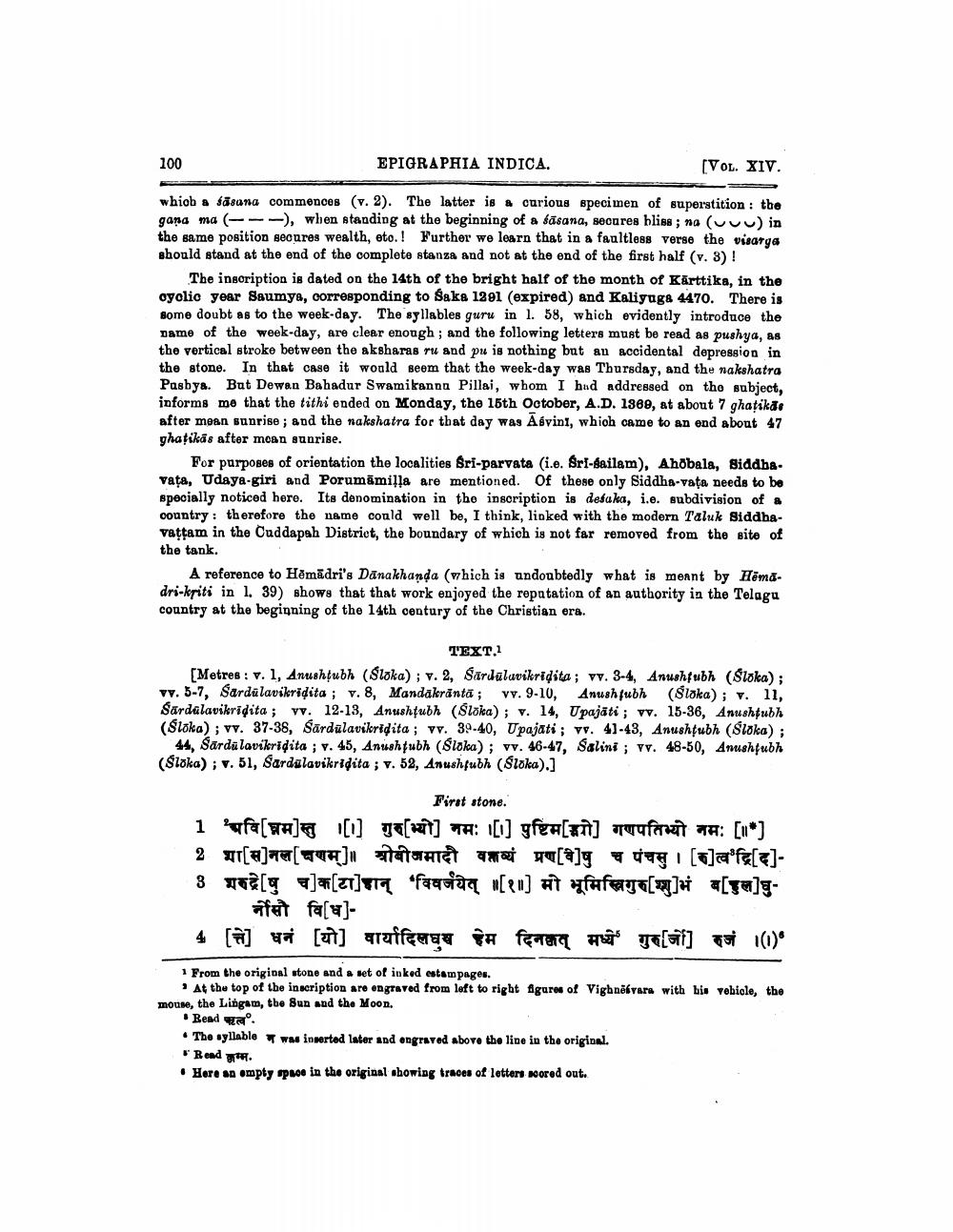________________
100
EPIGRAPHIA INDICA.
(VOL. XIV.
whiob a fāsana commences (v. 2). The latter is & curious specimen of superstition: the gana ma (---), when standing at the beginning of a fãsana, secures bliss; na (uvu) in the same position secures wealth, eto.! Further we learn that in a faultless verse the visarga should stand at the end of the complete stanza and not at the end of the first half (v. 3)!
The insoription is dated on the 14th of the bright half of the month of Kārttika, in the oyolic year Saumya, corresponding to Sake 1291 (expired) and Kaliyaga 4470. There is some doubt as to the week day. The syllables guru in l. 58, which evidently introduce the Dame of the week-day, are clear enough ; and the following letters must be read as pushya, as the vertical stroke between the aksharas tu and pu is nothing but an accidental depression in the stone. In that case it would seem that the week-day was Thursday, and the nakshatra Pasbya. But Dewan Bahadur Swamikanna Pillai, whom I hnd addressed on the subject, informs me that the tithi ended on Monday, the 15th October, A.D. 1960, at about 7 ghatikdo after mean sunrise ; and the nakshatra for that day was Asvini, which came to an end about 47 ghatikās after moan sunrise.
For purposes of orientation the localities Sri-parvata (i.e. Bri-dailam), Ahobala, Biddba. vata, Udaya-giri and Porumāmilla are mentioned. Of these only Siddha-vata needs to be specially noticed here. Its denomination in the inscription is desaka, i.e. subdivision of a country: therefore the name could well be, I think, linked with the modern Taluk Siddhavattam in the Cuddapah District, the boundary of which is not far removed from the site of the tank.
A reference to Hēmādri's Danakhanda (which is undoubtedly what is meant by Hömddri-kriti in I. 39) shows that that work enjoyed the reputation of an authority in the Telagu country at the beginning of the 14th century of the Christian ora.
TEXT.1 [Metres : v. 1, Anushţubh (Sloka); v. 2, Sarduluvikridita; v. 3-4, Anushubh (Sloka); vy. 5-7, Sardulavikridita ; v. 8, Mandakrāntā; vy. 9-10, Anushfubh (Sloka); v. 11, Sardalavikridita ; v. 12-13, Anushțubh (Sloka); v. 14, Upajāti; v. 15-36, Anushfubh (Sloka); vv. 37-38, Sārdūlavikridita; vv. 39-40, Upajati ; v. 41-43, Anushtubh (Sloka);
44, Sardūlavikridita ; v. 45, Anushtubh (Sloka); v. 46-47, Salini ; vv. 48-50, Anushfubh (Sloka); v. 51, Sardalavikridita ; v. 52, Anushfubh (Sloka).]
First stone. 1 [FA] [I] [it] TA: 10 gfe [an] ruft TA: [1*] 2 [a]T{7TH] The a i (@]y
(Ta'fes[x]3 [9 ] [71]'faqteq [Ru] At ufafar []* a[ym]g
et face)4 [9] 7 [1] araffeat A femer presentan ya[hi] H (1)
1 From the original stone and a set of inked estampages.
At the top of the inscription are engraved from left to right figure of Vighnökvara with his vehicle, the mouse, the Lingam, the Sun and the Moon.
Bead a • The syllable was inserted later and engraved above the line in the original.
Read . • Here so empty space in the original showing traces of letters Noored out.




